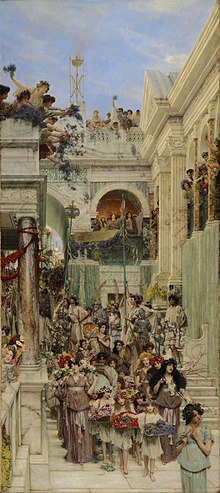
The spectacles in ancient Rome were numerous, open to all citizens and generally free of charge; some of them were distinguished by the grandeur of the stagings and cruelty.
Romans preferred to attend gladiatorial fights, those with ferocious beasts (venationes), reproductions of naval battles (naumachia), chariot races, athletic contests, theatrical performances by mimes, and pantomimes.
Forty years after the invective of Juvenal (n. between 55 and 60-m. after 127), who lamented the republican sobriety and severity of a people who now aspired only to panem et circenses, bread and spectacles, Fronto (100–166), in almost the same words, described disconsolately the sad reality:
Indeed, the Roman ruling class considered it its primary task to distribute food once a month to the people and to distract them and regulate their leisure time with the free entertainment offered on religious holidays or secular occasions.
- ^ Fronto, Princip. hist., V, 11
